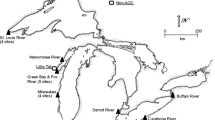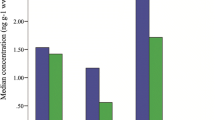Abstract
The hypothesis that the concentrations of 2,3,7,8-tetrachlorodibenzo-p-dioxin equivalents (TEqs) contributed by non-ortho- and mono-ortho-substituted (coplanar) PCB congeners have changed relative to total concentrations of PCBs over time was tested by analyzing eggs of red-breasted mergansers collected from the same locality in 1977–78 and in 1990. Twelve eggs from each time period were analyzed for coplanar PCBs, using a porous graphitic carbon HPLC column and GCECD. TEqs were calculated from coplanar PCB concentrations and bioassay-derived toxic equivalency factors. Median total PCB concentrations decreased from 25 to 13 μg/g, fresh weight (fw), and TEqs decreased from 320 pg/g to 160 pg/g, fw. The relative potency of the PCB mixtures, expressed as the ratio of TEqs contributed by the coplanar PCB congeners to total PCBs, did not change, nor did the ratio of concentrations of coplanar congeners to total PCBs. Thus, the relative potency of the mixture of PCBs in the eggs has not changed even as the concentrations declined significantly. The greater relative potency of TEqs relative to that which would be expected from the Aroclor® mixtures released into the environment is due to selective bioaccumulation, biomagnification, and metabolism, rather than as a result of differential weathering as a function of time.
Similar content being viewed by others
References
Armstrong DE, Marti EA (1990) Polychlorinated biphenyls in Lake Michigan tributaries. J Great Lakes Res 16:396–405
Boon JP, Eijgenraam F (1988) The possible role of metabolism in determining patterns of PCB congeners in species from the Dutch Wadden Sea. Marine Environ Res 24:3–8
Brown, JF, Lawton, RW, Ross MR, Feingold J (1991) In: O. Hutzinger and H. Fiedler (eds) Organohalogen Compounds, Vol 1: Toxicology, Environment Food Exposure-Risk. Ecoinforma Press, Bayreuth, Germany. pp 283–286
Brunström B (1991) Toxicity and EROD-inducing potency of polychlorinated biphenyls (PCBs) and polycyclic aromatic hydrocarbons (PAHs) in avian embryos. Comp Biochem Physiol 100C:241–243
Burkhard LP, Weininger D (1987) Determination of polychlorinated biphenyls using multiple regression with outlier detection and elimination. Anal Chem 59:1187–1190
Eisenreich SJ, Looney BB, Holdrinet M, Dodge DP, Nepszzy SJ (1981) Airborne organic contaminants in the Great Lakes ecosystem. Environ Sci Technol 15:30–38
Fox GA, Collins B, Hayakawa E, Weseloh DV, Ludwig JP, Kubiak TJ, Erdman TC (1991a) Reproductive outcomes in colonial fisheating birds: A biomarker for developmental toxicants in Great Lakes food chains. II. Spatial variation in the occurrence and prevalence of bill defects in young double-crested cormorants in the Great Lakes, 1979–1987. J Great Lakes Res 17:158–167
Fox GA, Weseloh DV, Kubiak TJ, Erdman TC (1991b) Reproductive outcomes in colonial fish-eating birds: A biomarker for developmental toxicants in Great Lakes food chains. I. Historical and ecotoxicological perspectives. J Great Lakes Res 17:153–157
Giesy JP, Ludwig JP, Tillitt DE (1994a) Dioxins, dibenzofurans, PCBs and similar chlorinated diaromatic hydrocarbons in and their effects on birds: Wildlife biomonitoring for hazards of complex environmental mixtures in the Laurentian Great Lakes. In: Schecter A (ed) Dioxins & Health. Plenum Press, NY, pp 254–307
Giesy JP, Ludwig JP, Tillitt DE (1994b) Deformities in birds of the Great Lakes Region: Assigning causality. Environ Sci Technol 28:128A-135A
Haseltine SD, Heinz GH, Reichel WL, Moore JF (1981) Organochlorine and metal residues in eggs of waterfowl nesting on islands in Lake Michigan off Door County, Wisconsin, 1977–78. Pestic Monit J 15:90–97
Hebert CE, Norstrom RJ, Simon M, Braune BM, Wesseloh DV, Macdonald CR (1994) Temporal trends and sources of PCDDs and PCDFs in the Great Lakes: Herring gull egg monitoring, 1981–1991. Environ Sci Technol 28:1268–1277
Heinz GH, Miller DS, Ebert BJ, Stromborg KL (1994) Declines in organo chlorines in eggs of red-breasted mergansers from Lake Michigan, 1977–78 versus 1990. Environ Monit Assess (in press)
Jones PD, Giesy JP, Newsted JL, Verbrugge DA, Beaver DL, Ankley GT, Tillitt DE, Lodge KB, Niemi GJ (1993a) 2,3,7,8-Tetrachlorodibenzo-p-dioxin equivalents in tissues of birds at Green Bay, Wisconsin, USA. Arch Environ Contam Toxicol 24:345–354
Jones PD, Ankley, GT, Best DA, Crawford, R, Degalan, N, Giesy, JP, Kubiak TJ, Ludwig JP, Newsted JL, Tillitt DE, Verbrugge DA (1993b) Biomagnification of bioassay-derived 2,3,7,8-tetrachlorodibenzo-p-dioxin equivalents. Chemosphere 26:1203–12121
Kannan N, Tanabe S, Wakimoto T, Tatsukawa R (1987) Coplanar polychlorinated biphenyls in Aroclor and Kanechlor mixtures. J Assoc Offic Anal Chem 70:451–454
Kannan N, Tanabe S, Tatsukawa R (1989) Persistency of highly toxic coplanar PCBs in aquatic ecosystems: Uptake and release kinetics of coplanar PCBs in green-lipped mussels (Perna viridis Linnaeus). Environ Pollut 56:65–76
Kubiak TJ, Harris HJ, Smith LM, Schwartz TR, Stalling DL, Trick JA, Sileo L, Docherty D, Erdman TC (1989) Microcontaminants and reproductive impairment of the Forster's tern on Green Bay, Lake Michigan-1983. Arch Environ Contam Toxicol 18:706–727
Muir DCG, Yarechewski AL, Knoll A, Webster GRB (1986) Bioconcentration and disposition of 1,3,6,8-tetrachloro-dibenzo-p-dioxin and octachlorodibenzo-p-dioxin by rainbow trout and fathead minnows. Environ Toxicol Chem 5:261–272
Oliver BG, Charlton MN, Durham RW (1989) Distribution, redistribution, and geochemistry of polychlorinated biphenyl congeners and other chlorinated hydrocarbons in lake Ontario sediments. Environ Sci Technol 23:200–208
Poland A, Knutson JC (1982) 2,3,7,8-tetrachlorodibenzo-p-dioxin and related halogenated aromatic hydrocarbons: Examination of the mechanism of toxicity. Ann Rev Pharmacol Toxicol 22:517–554
Pruell RJ, Bowen RD, Fluck SJ, LiVolsi JA, Cobb DJ, Lake JL (1988) PCB congeners in American lobster, Homarus americanus, and winter flounder, Pseudopleuronectes americanus, from New Bedford Harbor, Massachusetts. USEPA Environmental Assessment Group Report 180 pp
Safe S (1990) Polychlorinated biphenyls (PCBs), dibenzo-p-dioxins (PCDDs), dibenzofurans (PCDFs), and related compounds: Environmental and mechanistic considerations which support the development of toxic equivalency factors (TEFs). Crit Rev Toxicol 21:51–88
Schwartz TR, Stalling DL (1991) Chemometric comparison of polychlorinated biphenyl residues and toxicologically active polychlorinated biphenyl congeners in the eggs of Forster's Terns (Sterna forsteri). Arch Environ Contam Toxicol 20:183–199
Stickel LF, Wiemeyer SN, Blus LJ (1973) Pesticide residues in eggs of wild birds: Adjustment for loss of moisture and lipid. Bull Environ Contam Toxicol 9:193–196
Swackhamer DL, Armstrong DE (1988) Horizontal and vertical distribution of PCBs in southern Lake Michigan sediments and the effect of Waukegon Harbor as a point source. J Great Lakes Res 14:277–290
Tanabe S (1988) PCB problems in the future: Foresight from current knowledge. Environ Pollut 50:5–28
Tillitt DE, Giesy JP, Ankley GT (1991) Characterization of the H4IIE rat hepatoma cell bioassay as a tool for assessing toxic potency of planar halogenated hydrocarbons in environmental samples. Environ Sci Technol 25:87–92
Tillitt DE, Ankley GT, Giesy JP, Ludwig JP, Kurita-Matsuba H, Weseloh DV, Ross PS, Bishop CA, Sileo L, Stromborg KL, Larson J, Kubiak TJ (1992) Polychlorinated biphenyl residues and egg mortality in double-crested cormorants from the Great Lakes. Environ Toxicol Chem 11:1281–1288
Tori GM, Peterle TJ (1983) Effects of PCB on mourning dove courtship behavior. Bull Environ Contam Toxicol 30:44–49
Van den Berg M, Blank F, Heeremans C, Wagenaar H, Olie K (1987) Presence of polychlorinated dibenzo-p-dioxins and polychlorinated dibenzofurans in fish-eating birds and fish from The Netherlands. Arch Environ Contam Toxicol 16:149–158
Verbrugge DA, Giesy JP, Mora MA, Williams LL, Crawford RM, Rossman R, Moll RA, Tuchman, ML (1994) Concentrations of dissolved and particulate PCBs in water from the Saginaw River, Michigan. J Gt Lakes Res (in press)
Williams, LL (1993) Characterization and application of a semi-automated separation and analysis technique for polychlorinated biphenyls in Great Lakes Wildlife. PhD Dissertation, Michigan State University, East Lansing, Michigan. 61 pp
Williams LL, Giesy JP, DeGalan N, Verbrugge DA, Tillitt DE, Ankley GT, Welch RA (1992) Prediction of concentrations of 2,3,7,8TCDD equivalents (TCDD-EQ) in trimmed chinook salmon fillets from Lake Michigan from total concentrations of PCBs and fish size. Environ Sci Technol 18:108–124
Williams LL, Giesy JP (1994) Characterization studies of a semiautomated separation method for analysis of non-ortho-substituted polychlorinated biphenyl (PCB) congeners in environmental samples. Ecol Toxicol Chem (in press)
Williams LL, Giesy JP, Verbrugge DA, Jurzysta S, Larson J, Stromborg K (1994) Reproductive success, polychlorinated biphenyls, and 2,3,7,8-tetrachlorodibenzo-p-dioxin equivalents in eggs of double-crested cormorants from a colony near Green Bay, Wisconsin, USA. Arch Environ Contamn Toxicol (submitted)
Yamashita N, Tanabe S, Ludwig JP, Kurita H, Ludwig ME, Tatsukawa R (1993) Embryonic abnormalities and organochlorine contamination in double-crested cormorants (Phalacorcorax auritus) and Caspian terns (Hydroprogne caspia) from the upper Great Lakes. Environ Pollut 79:163–173
Author information
Authors and Affiliations
Rights and permissions
About this article
Cite this article
Williams, L.L., Giesy, J.P., Verbrugge, D.A. et al. Polychlorinated biphenyls and 2,3,7,8-tetrachlorodibenzo-p-dioxin equivalents in eggs of red-breasted mergansers near Green Bay, Wisconsin, USA, in 1977–78 and 1990. Arch. Environ. Contam. Toxicol. 29, 52–60 (1995). https://doi.org/10.1007/BF00213087
Received:
Revised:
Issue Date:
DOI: https://doi.org/10.1007/BF00213087




